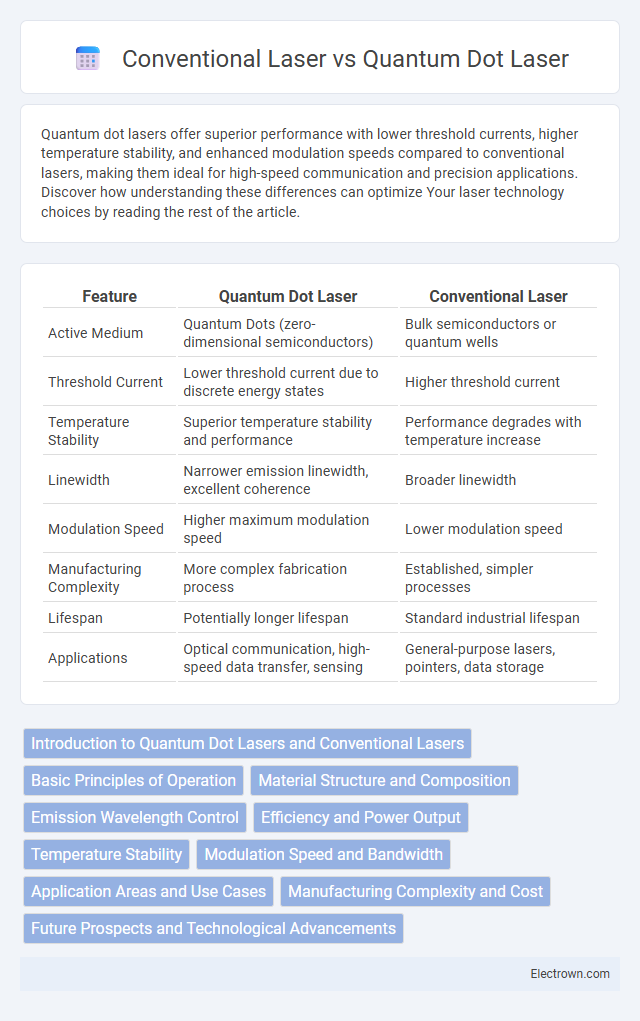Quantum dot lasers offer superior performance with lower threshold currents, higher temperature stability, and enhanced modulation speeds compared to conventional lasers, making them ideal for high-speed communication and precision applications. Discover how understanding these differences can optimize Your laser technology choices by reading the rest of the article.
Table of Comparison
| Feature | Quantum Dot Laser | Conventional Laser |
|---|---|---|
| Active Medium | Quantum Dots (zero-dimensional semiconductors) | Bulk semiconductors or quantum wells |
| Threshold Current | Lower threshold current due to discrete energy states | Higher threshold current |
| Temperature Stability | Superior temperature stability and performance | Performance degrades with temperature increase |
| Linewidth | Narrower emission linewidth, excellent coherence | Broader linewidth |
| Modulation Speed | Higher maximum modulation speed | Lower modulation speed |
| Manufacturing Complexity | More complex fabrication process | Established, simpler processes |
| Lifespan | Potentially longer lifespan | Standard industrial lifespan |
| Applications | Optical communication, high-speed data transfer, sensing | General-purpose lasers, pointers, data storage |
Introduction to Quantum Dot Lasers and Conventional Lasers
Quantum dot lasers utilize semiconductor nanocrystals as the active gain medium, enabling superior performance in terms of lower threshold current, higher temperature stability, and enhanced modulation speed compared to conventional lasers that rely on bulk or quantum well structures. Conventional lasers primarily depend on electron-hole recombination in uniform semiconductor materials, resulting in less efficient carrier confinement and broader emission spectra. Your choice between these two laser types can significantly impact applications in optical communications, sensing, and quantum computing due to differences in emission wavelength tunability and device scalability.
Basic Principles of Operation
Quantum dot lasers operate by confining electrons and holes in nanoscale semiconductor particles, enabling discrete energy levels and enhanced carrier recombination efficiency. Conventional lasers rely on bulk semiconductor materials where electrons and holes occupy continuous energy bands, limiting control over emission wavelength and threshold current. The quantum confinement effect in quantum dot lasers leads to superior temperature stability, lower threshold currents, and more precise wavelength tunability compared to conventional laser diodes.
Material Structure and Composition
Quantum dot lasers utilize nanoscale semiconductor particles embedded in a matrix, offering discrete energy states due to quantum confinement, unlike conventional lasers which rely on bulk or quantum well structures with continuous energy bands. The quantum dot material composition, often InAs/GaAs or InP systems, enables enhanced carrier confinement and reduced threshold current, improving efficiency and temperature stability. Your choice of laser technology should consider how quantum dot structures provide superior performance in wavelength tunability and modulation speed compared to traditional semiconductor lasers.
Emission Wavelength Control
Quantum dot lasers offer superior emission wavelength control due to their size-tunable quantum confinement effects, allowing precise wavelength adjustment by altering the dot dimensions. Conventional lasers rely on bulk semiconductor properties, limiting wavelength tunability and often requiring complex external cavity modifications for wavelength shifts. The discrete energy levels in quantum dots enable stable, narrow linewidth emission, enhancing performance in applications demanding exact wavelength specifications.
Efficiency and Power Output
Quantum dot lasers demonstrate superior efficiency compared to conventional lasers due to reduced threshold currents and enhanced carrier confinement, which minimize energy loss. Their power output is often higher at elevated temperatures, maintaining stable performance where conventional lasers experience significant efficiency drops. This stability and efficiency make quantum dot lasers ideal for applications requiring reliable, high-power illumination in compact devices.
Temperature Stability
Quantum dot lasers exhibit superior temperature stability compared to conventional lasers due to their discrete energy states that reduce carrier leakage and threshold current variations. This stability allows quantum dot lasers to maintain consistent performance across a wider temperature range, enhancing device reliability in environments with fluctuating temperatures. Your optical systems benefit from these characteristics by achieving more efficient and stable laser output under varying thermal conditions.
Modulation Speed and Bandwidth
Quantum dot lasers offer significantly higher modulation speeds and broader bandwidths compared to conventional lasers due to their discrete energy levels and reduced carrier scattering. Their unique quantum confinement enables faster carrier dynamics, resulting in modulation frequencies exceeding tens of gigahertz, ideal for high-speed optical communication. Your optical systems can benefit from enhanced data transmission rates and improved signal integrity when utilizing quantum dot laser technology.
Application Areas and Use Cases
Quantum dot lasers excel in telecommunications, medical diagnostics, and advanced display technologies due to their superior temperature stability and wavelength tunability. Conventional lasers remain dominant in industrial cutting, barcode scanning, and optical storage, benefiting from established reliability and cost-effectiveness. Your choice depends on whether precision and efficiency in specialized fields or broad, cost-efficient performance in traditional applications matter more.
Manufacturing Complexity and Cost
Quantum dot lasers involve intricate manufacturing processes such as molecular beam epitaxy, leading to higher production costs compared to conventional lasers that utilize simpler epitaxial layers. The precision required to create uniform quantum dots increases fabrication time and equipment expenses, influencing overall pricing. Your choice between these laser types should consider the trade-off between the advanced performance of quantum dot lasers and the more cost-effective, established manufacturing of conventional lasers.
Future Prospects and Technological Advancements
Quantum dot lasers exhibit superior temperature stability, lower threshold currents, and enhanced modulation speeds compared to conventional lasers, making them highly promising for future photonic integrated circuits and high-speed optical communication systems. Advances in epitaxial growth techniques and material engineering continue to improve quantum dot uniformity and device reliability, driving their commercialization potential. You can expect quantum dot laser technology to play a critical role in next-generation applications, including optical data transmission, sensing, and quantum computing.
quantum dot laser vs conventional laser Infographic

 electrown.com
electrown.com